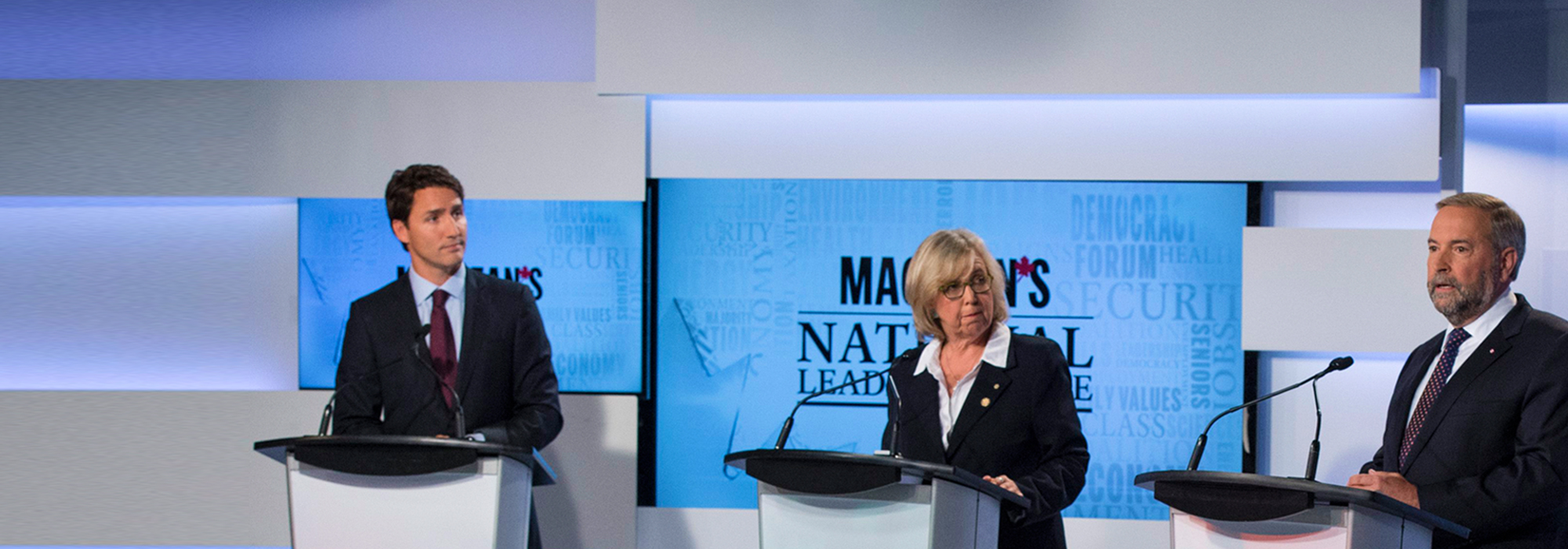
This special Policy Options feature on leaders’ debates, which stemmed from an IRPP colloquium last year in Ottawa, is a good opportunity to look at the subject without the noise and partisanerie of a federal election.
As Paul Adams and Elly Alboim eloquently argue, the public interest should come before that of the broadcasters and the political parties when deciding the correct policy path to take.
I come at the issue from a slightly different angle.
The leaders’ debates are the kind of program on TV that naturally inspire some living room heckling. The TVA “Face à Face 2015” program, the fifth and final one in the last election, had me yelling at the screen even before the leaders took the stage.
The pre-debate show featured four men, all well-known commentators in the province. But come on (ben coudon, as one of my favourite Twitter feeds likes to say about these sorts of all male panels, or “manels”) — Quebec’s largest private television network couldn’t locate a single French-speaking woman in the entire country to wax on about the election?
The debate proceeded with the four male party leaders and a male moderator.
The gender issue was a symptom of a larger problem. The TVA show was a really great example of the insularity of the entire debate process, which doesn’t reach out to include all Canadians, and it certainly doesn’t always reflect Canada’s wonderful diversity.
The debates have the same essential flaws that plague media coverage of federal elections. The whole exercise is a top-down affair — instead of being driven by citizens, political and newsroom leaders decide on the election issues. Meanwhile, fine newspapers and networks publish polls on which party is apparently winning or losing, but don’t have the bucks to pay for research to determine what voters care most about.
The debates we get are conceived by the same small group of individuals that cover and comment on politics, who generally hail from Ottawa, Montreal and Toronto, are usually white, and are predominantly male. Yes, I count myself as part of this general circle. We’re all well-intentioned, and we’re not too shabby at analysis, formulating incisive questions and injecting context, but do we really know what questions people in Selkirk, the Nipissing First Nation and Trois-Rivières want asked during a debate?
A good argument could be made that the CBC, which was a central player in the debate consortium, would be well placed to organize a debate that takes into consideration regional issues and questions important to indigenous people, women, and the elderly. The CBC’s mandate under the Broadcasting Act requires it to “reflect the multicultural and multiracial nature of Canada” and to “reflect Canada and its regions.”
Past consortium debates have featured carefully selected questions from the public, aimed at representing Canadian diversity. CBC senior producer Bob Weiers wrote a valuable column about how a consortium arrived at questions for one Ontario debate. The CBC’s broadcast experiment during the 2015 election in which average Canadians got to interview Justin Trudeau, “Face to Face with the Prime Minister,” was perhaps the most interesting recent attempt at having voters drive the discussion. It was fascinating to watch, and the CBC should do it again.
But the consortium, by definition, was not inclusive. It was an opaque operation that issued the occasional press release but generally kept discussions inside a closed room. If the process foreseen in 2015 did include a way for the masses to provide input on consortium debate questions, I have no idea what it was.
An independent body dedicated to setting rules and organizing debates could ensure there is a rich consultation beforehand that includes a broader swath of Canadians. It could engage in extensive social media outreach, notably with young people (as Vincent Raynauld has suggested in these pages). Simultaneous translation into other languages could be negotiated with ethnic media.
Such an arms-length institution could force a rethink of how viewers and listeners are engaged in such an important moment during the election, while stopping short of dictating questions or the choice of moderator on debates hosted by networks or other organizations.
With such a body setting the tone of inclusiveness, it’s highly unlikely that we would end up with five debates and only one female moderator. (In 2015, it was Radio-Canada’s Anne-Marie Dussault, although she didn’t actually ask questions, her two male colleagues did). It is also highly unlikely that something like closed captioning would be an afterthought – as it appeared to be at the beginning of last year’s campaign.
And if you’re wondering whether ensuring diversity in the development of debates will produce marginal, dull programming, take a gander at the coverage in the US of Univision’s Democratic debate. Guatemalan immigrant Lucia Quiej’s question to Sanders and Clinton was not only poignant, it also elicited responses from the candidates that informed all voters, not just interested Latinos.
In the next election, who will be waiting to ask questions out in the audience? We can afford a little extra bureaucracy to find out.
On a personal note, this is my first column since taking over as editor-in-chief of Policy Options. As a wise friend said to me recently, the magazine has a role to play in “nourishing” the public policy debate in Canada. I look forward to hearing from readers about the issues you would like to see us explore in these pages.
This article is part of the Future of Leaders’ Debates special feature.







